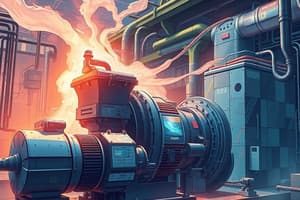Podcast
Questions and Answers
Why would a DC generator run in a clockwise direction only?
Why would a DC generator run in a clockwise direction only?
- To avoid damage to the brushes (correct)
- To maintain efficient energy conversion
- To ensure proper armature rotation
- To enhance magnetic field lines
What type of DC generator has its field connected parallel with the armature?
What type of DC generator has its field connected parallel with the armature?
- Shunt generator (correct)
- Differential compound generator
- Short shunt compound generator
- Series generator
What distinguishes a differential compound generator from other types?
What distinguishes a differential compound generator from other types?
- It has a larger armature core
- It integrates both shunt and series features
- It opposes the series field winding (correct)
- It operates without a field winding
What is a common reason for failure of a DC generator to produce voltage?
What is a common reason for failure of a DC generator to produce voltage?
What is the primary function of the pole shoe in a DC generator?
What is the primary function of the pole shoe in a DC generator?
What is the key feature of a compound generator?
What is the key feature of a compound generator?
Why are rotating compensation tanks provided in large DC generators?
Why are rotating compensation tanks provided in large DC generators?
What type of generator features a cumulative compound configuration?
What type of generator features a cumulative compound configuration?
Which of the following scenarios describes a differential compound DC generator?
Which of the following scenarios describes a differential compound DC generator?
What effect does eddy current loss have on a DC generator's performance?
What effect does eddy current loss have on a DC generator's performance?
Flashcards are hidden until you start studying
Study Notes
DC Generators Overview
- Components include steel, graphite, cast iron, and aluminum materials for various parts.
- Graphite is essential for brushes, providing improved conductivity and reduced wear.
Residual Magnetism Loss
- Causes of residual magnetism loss:
- Heavy short circuit under load.
- Continuous operation without load.
- Running without brake.
- Frequent changes in direction of rotation.
Magnetic Circuits and Field Coils
- Magnetic circuit in a generator is completed through yoke and poles, primarily involving field coils.
Terminal Voltage Behavior
- Terminal voltage in a DC shunt generator decreases under increased load due to:
- Ampere feedback effect.
- Increased resistance impacting current flow.
Types of DC Generators
- Used for long-distance distribution: Shunt generator preferred for stability.
- Arc welding applications: Series generator provides high current output.
- Wave winding specialty: Configured for voltage ranging from low to high voltage applications.
Insulation Resistance Maintenance
- Insulation resistance can be improved by:
- Regularly cleaning commutator segments.
- Periodically warming the machine.
- Adequate airing during maintenance.
Functionality Without Residual Magnetism
- A separately excited generator can operate effectively without residual magnetism.
Commutator and Resistor Roles
- Resistors in commutator connections:
- Help in maintaining constant voltage.
- Facilitate smooth reversal of current direction.
Parallel Generator Operation Conditions
- For generators to operate in parallel:
- Capacities must match.
- Field currents need to be uniform.
- Polarity has to be identical.
Common Issues Impacting Output
- Factors that may cause a DC generator to fail in producing voltage:
- Loose brush contact.
- Idle generator conditions.
Key Generator Concepts
- Pole shoes help to:
- Reduce air gap.
- Increase field strength.
- Spread magnetic flux evenly.
- Split rings are utilized to:
- Maintain unidirectional current collection.
Material Usage
- Brushes in generators are typically made from conductive materials, often involving copper or graphite composites for efficiency and lower resistance.
Studying That Suits You
Use AI to generate personalized quizzes and flashcards to suit your learning preferences.




